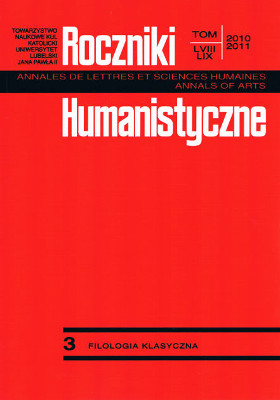Oblicza Demeter u Kallimacha z Cyreny
Abstrakt
The article considers the characters of goddess Demeter in the sixth hymn of Callimachus To Demeter. Analysis of heroine’s image must show the author’s skill in composing the hymn’s narration, as well as his good knowledge of religious ceremonies and his attitude toward the glorified deity. Namely the study of goddess’s epithets (sometimes hidden) used in hymn aims to present Demeter’s images: Demeter as a mourning mother, goddess of crops, fruits and cattle, giver of happiness, health and season-bringing goddess; Demeter as a law-giver. One can observe how Callimachus skillfully changes his narration; together with such transitions from mimetic to non-mimetic frame changes the character of Demeter. The hymn starts with the ritual scene of carrying kalathos (a special basket) on the holiday honoring the goddess, where the poet shows special rules for ancient women in her worshiping. Next goes a scene from the myth of Persephone’s rape and Demeter’s wandering in searching her lost daughter. But the poet decides to interrupt this story and to start a new one – a cautionary tale about Erysichthon’s crime in the Demeter’s sacred grove and his punishment by fair goddess. Here is heard the main idea: no one can escape from the god’s will and its’ power. In the end Callimachus returns to mimetic frame and here Demeter appears again in her full glory and as a giver of many benefits for people.
Bibliografia
Appel W.: Homerika czyli żywoty Homera i poematy przypisywane poecie, Warszawa 2007.
Burkert W.: Starożytne kulty misteryjne, Kraków 2007.
Chantraine P.: Dictionnaire étymologique de la langue grecque. Histoire des mots. Λ-Ω, Paris 1984.
Danielewicz J.: Morfologia hymnu antycznego, Poznań 1976.
Farnell L.R.: Cults of the Greek States, III, Oxford 1906.
Harder M.A.: ‘Mimetic’ and ‘Non-mimetic’ Hymns, „Classical Quarterly” (42) 1992, s. 384-394.
Henrichs A.: Gods in Action: The Poetics of Divine Performance in the Hymn of Callimachus, w: A. Harder (ed.), Callimachus, Groningen 1993, s. 127-145.
Hopkinson N.: Callimachus: Hymn to Demeter, Cambridge 1984.
Horowski J.: Folklor w twórczości Kallimacha z Cyreny, Poznań 1967.
Howald E., Staiger E.: Die Dichtungen des Kallimachos, Zürich 1955.
Kerenyi K.: Eleusis. Archetypowy obraz matki i córki, Kraków 2004.
Klinger W.: Z poezji Kallimacha z Cyreny, Wrocław 1948.
McKay K.G.: Erysichthon. A Callimachean Comedy, Leiden 1962.
Müller K.W.: Erysichton, Mainz–Stuttgart 1987.
Nilsson M.: Griechische Feste von religiöser Bedeutung (mit Ausschluss der Attischen), 3rd ed. 1922, repr. New York 1975.
Pfeiffer R.: Callimachus. Fragmenta, vol. I, Oxford 1949.
Pfeiffer R.: Callimachus. Hymni et epigrammata, vol. II, Oxford 1953.
Spanoudakis K.: Callimachus Fr. 1. 9-12 Again, „Zeitschrift für Papyrologie und Epigraphik” 121 (1998), s. 59-61.
Spanoudakis K.: Philitas of Cos, Brill 2002.
Świderkówna A.: Bogowie zeszli z Olimpu, Warszawa 2008.
Tress van H.: Poetic Memory. Allusion in the Poetry of Callimachus and the Metamorphoses of Ovid, Leiden–Boston 2004.
Wilamowitz U. von: Hellenistische Dichtung in der Zeit der Kallimachos, Bd. II, Berlin 1924.
Zieliński T.: Erysichton, „Philologus” 4 (1891), s. 137-162.
Copyright (c) 2011 Roczniki Humanistyczne

Utwór dostępny jest na licencji Creative Commons Uznanie autorstwa – Użycie niekomercyjne – Bez utworów zależnych 4.0 Międzynarodowe.





